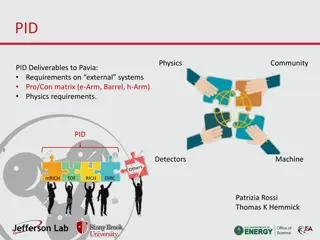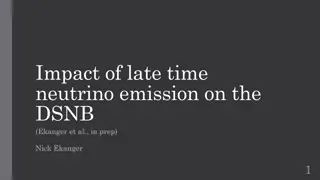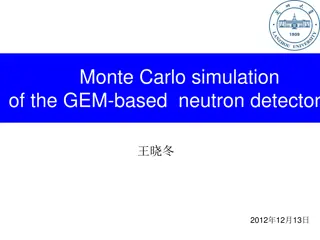Neutrino Detectors for NuStorm: Physics Goals and Detector Requirements
Physics goals for neutrino detectors in the NuStorm project include measuring exclusive neutrino cross sections, supporting long baseline programs, searching for sterile neutrinos, and improving measurements. Detector requirements involve reconstructing neutrino interactions, providing charge and particle identification, and detecting protons and neutrons. Meeting these requirements with a single detector is challenging, necessitating inspiration from existing systems and experiences. Oscillation measurements require multiple detectors with varied baselines for accurate results.
Uploaded on Sep 07, 2024 | 0 Views
Download Presentation

Please find below an Image/Link to download the presentation.
The content on the website is provided AS IS for your information and personal use only. It may not be sold, licensed, or shared on other websites without obtaining consent from the author. Download presentation by click this link. If you encounter any issues during the download, it is possible that the publisher has removed the file from their server.
E N D
Presentation Transcript
Thoughts on Neutrino Detectors for NuStorm NEIL MCCAULEY UNIVERSITY OF LIVERPOOL
Physics Goals Measure exclusive neutrino cross sections at the 1% level Support the long baseline programme (DUNE, HK). Measure electron neutrino cross sections Measure cross sections with multi particle final states + full kinematics Constrain the elements of neutrino-nucleus scattering models Search for Sterile neutrinos Or improve measurements following positive results at Fermilab SBL programme Multiple baselines Excellent neutrino energy reconstruction
Reminder: Oscillation experiments The idea is simple: compare the rates at near and far detector We measure the results of the neutrino interactions, but oscillations affect the neutrinos themselves. The spectrum is different at near and far detectors Neutrino cross sections are essential to understand the effect on the measurements We have to estimate neutrino energy or a proxy for it CCQE Neutrino energy reconstruction at T2K Calorimetric
Breaking apart cross sections Cross section models are combinations of several parts Free nucleons CCQE, Resonant, DIS Initial states, including state correlations Final state interactions Measurements that can decouple these will help build better models
Detector Requirements We need to reconstruct the products of the neutrino interactions. Our detector is also our target. Keep in mind the physics goals and beam composition Detectors should provide Charge Identification - Magnetise Momentum Reconstruction Curvature/Path length Particle Identification - muons/electrons/pions/protons/photons Reconstruction of multiple particles most interactions will produce at least 2 Requirement for any kind of calorimetric neutrino energy reconstruction Detection of protons and neutrons at low threshold nuclear effects Variety of nuclear targets Minimum of Ar and H2O. Also C (HK and DUNE ND comparisons). Strong case for H & D if possible.
Detector Systems Meeting all requirements with a single detector looks challenging. Take inspiration from HK + DUNE ND systems + experience from T2K, Minerva, MiniBooNe, MicroBooNe etc. For oscillation measurement multiple detectors with multiple baselines are essential. General point, I assume beam timing is sufficient to remove cosmic backgrounds, but some minimal overhead, is likely desirable.
T2K Reminder HK ND/ND280 Upgrade
Reminder HK intermediate detector
Detector 1 Liquid Argon TPC Two concepts to consider, single phase and dual phase Single Phase wire detection think ProtoDune SP, MicroBooNe, SBND, DUNE Ar target Excellent track reconstruction Should be a proven technology in time for nuStorm No magnetic field, relatively high proton threshold, neutron detection?
Dual Phase Options Multiple read out options for dual phase, optical readout is one interesting option Ariadne: Fast optical imaging High resolution (~mm pixels) Low threshold (~100 keV) Small number of channels compared to wires Use image intensifiers and cameras to measure secondary scintillation light from THGEM holes Use TPX3Cam fast cameras for readout Accurate calorimetry Accurate timing (1.6 ns) for full 3D reconstruction Zero suppressed readout
Gallery and video of Cosmics interacting in LAr THGEM field 29kV/cm Resolution 1.1mm/pixel Stopping muon Michel electron Continuous streaming, 10 msec slice Gammas Stopping muon candidate Antiproton candidate
Detector 2 ND280UP/ Sand inspired Tracking detectors have led current cross section measurement programmes and can continue to do so in the liquid argon era. Especially for alternative nuclei. Super FGD style detectors are currently leading way here. Scintillating cubes read out by wavelength shifting fibres. C target. Can investigate using hollow cubes filled with water and WBLS for water target. Alternatively use water layers WAGASCI concept Would desire a fully plastic scintillator region as well. Good proton detection and some neutron detection as well
Fitting this into the rest of the detector Surround the sFGD with TPC Lack of high angle tracks in ND280 has been a major issue Need to extrapolate models to unmeasured parts of phase space and match far detector acceptance Major part of ND280 upgrade TPC will have excellent momentum resolution for charged tracks and excellent PID (with some exceptions) Surround this with ECAL Similar to but more sophisticated than ND280 Gamma catcher at front (no lead) Detector low energy (c. 50 MeV) photons HCAL at rear- (thicker lead or iron) pions to shower to improve PID Overall can catch everything that leaves the interaction and patch PID inefficiencies in TPC Time of Flight Could be part of electronics for sFGD and ECAL or dedicated detector. Sense of tracks must be known to reduce backgrounds Further PID Magnet to surround entire detector Yoke could form part of HCAL, but must be designed in Momentum in TPC and track sign
Cartoon of such a detector Magnet ECAL TOF TPC sFGD sFGD H2O
Extra Options HPTPC Similar to detector 2 but replace sFGD and TPC with a high pressure TPC Third detector option for DUNE Advantage of lower proton threshold Allows improved measurements of various nuclear effects Fewer pile up concerns than other detectors Gas mixture changes allow measurement on different nuclei Oxygen may be a problem Theoretical opportunity for H and D measurements. Additional safety factors to overcome Current research on such detectors is active in the UK
Extra Options Water Cherenkov Well understood technology provides a water taget Better matched to energies slightly lower than nustorm Issues with amount of overburden. Muon momentum reconstruction is problematic Need to range out in detector, but such a large detector will have pile up and overburden problems
Extra Options Emulsion detectors Very fine scale tracking Have to backup emulsion with additional detectors to find vertex Need to photograph and scan emulsion Speed of this process has been increasing Potentially the cleanest way to detect if this become an important physics goal Most recent example is Ninja at JPARC
Extra Options Magnetised Iron Spectrometer Most likely to act a companion to another technology to provide muon momentum reconstruction Emulsion, Water Cherenkov Does not provide 4 measurement Baby MIND at JPARC is a prime example Spectrometer for WAGASCI and Ninja Baby Mind @ JPARC
Oscillation Detection For an idealised oscillation experiment you would prefer the same target in near and far detectors Not achieved in LarTPC and tracker plan Moveable detectors are part of HK and DUNE ND plans Use off axis angle to change the neutrino spectrum and improve physics extraction through the extra controls. For oscillations the same idea can be used to control L For example imagine putting one of the detectors in rail track inside a tunnel. Excellent cancelation of systematics for high precision sterile neutrino experiment.
Summary I ve discussed my personal thoughts on possible detectors for nustorm Detector choices will have been missed or glossed over. Extraction of the full potential of the beam will require multiple detectors We should aim to collect detailed cross section data on at least Ar and O A serious consideration of H and D targets should be made to get to bare nucleon cross sections A Liquid Argon TPC and an improved magnetised tracker are two clear detector choices that can be made. Additional detector technologies are available and should also be pursed






















